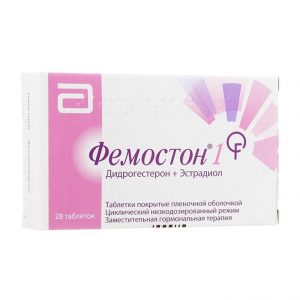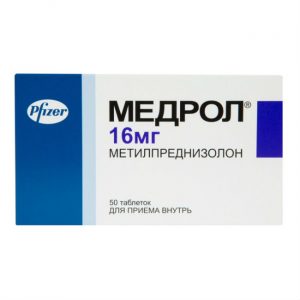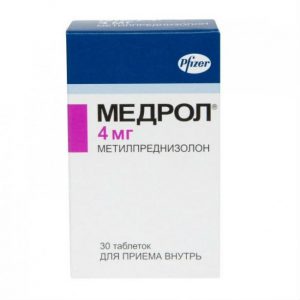Description
Latin name
Dexamethasone
Release form
Solution for injection
Packing
25 ampoules of 1 ml.
Pharmacological action
Dexamethasone is a synthetic glucocorticoid drug that contains a fluorine atom.
It has a pronounced anti-inflammatory, anti-allergic and desensitizing effect, has immunosuppressive activity. Slightly retains sodium and water in the body. These effects are associated with inhibition of the release of inflammatory mediators by eosinophils by inducing the formation of lipocortins and a decrease in the number of mast cells producing hyaluronic acid with a decrease in capillary permeability by stabilization of cell membranes (especially lysosomal) and organelle membranes. The immunosuppressive effect is due to inhibition of the release of cytokinins (interleukin 1, 2, interferon gamma) from lymphocytes and macrophages. The main effect on metabolism is associated with protein catabolism, an increase in gluconeogenesis in the liver and a decrease in glucose utilization by peripheral tissues.
The drug inhibits the activity of vitamin D, which leads to a decrease in calcium absorption and an increase in its excretion. Dexamethasone inhibits the synthesis and secretion of ACTH and, secondly, the synthesis of endogenous glucocorticoids. A feature of the drug is a significant inhibition of pituitary function and a complete absence of mineralocorticoid activity.
Pharmacokinetics of
In the blood binds (60-70%) to a specific carrier protein – transcortin. It easily passes through histohematological barriers (including through the blood-brain and placental).
Metabolized in the liver (mainly by conjugation with glucuronic and sulfuric acids) to inactive metabolites.
It is excreted by the kidneys (a small part – by the lactating glands). T1 / 2 of dexamethasone from plasma – 3-5 hours.
Indications
Given the indications and prescribed doses, they are recommended for the treatment of all those diseases that can be treated systemically with glucocorticoids (if necessary as an additional treatment to the main one), if topical treatment or oral administration is impossible or ineffective:
shock of various origins (anaphylactic, post-traumatic, postoperative, cardiogenic, blood transfusion, etc.)
cerebral edema (with brain tumor, traumatic brain injury, neurosurgical intervention stve, bleeding in the brain, encephalitis, meningitis, radiation injury)
asthmatic status
severe allergic reactions (angioedema, bronchospasm, dermatosis, acute anaphylactic reaction to medication, transfusion serum pyrogenic reactions)
acute hemolytic anemia, thrombocytopenia, agranulocytosis
acute lymphoblastic leukemia
severe infectious diseases (in combination with antibiotics)
acute adrenal cortex
acute croup
disease diseases or (acute) humeroscapular periarthritis, epicondylitis, styloiditis, bursitis, tendovaginitis, compression neuropathy, osteochondrosis, arthritis of various etiologies, osteoarthritis)
diagnosis Stick adrenocortical insufficiency, pituitary dwarfism (in children), affective disorders, including with depression.
Contraindications
Arterial hypertension, Itsenko-Cushing’s disease, psychosis, renal failure, osteoporosis, gastric and duodenal ulcer, bacterial endocarditis, syphilis, tuberculosis, diabetes mellitus, pregnancy, systemic mycosis joint infections, obesity of the III-IV stage, hypersensitivity to dexamethasone
Use during pregnancy and lactation
During pregnancy (especially in the first trimester), the drug can be used only when the expected therapeutic effect exceeds the potential risk to the fetus. With prolonged therapy during pregnancy, the possibility of impaired fetal growth is not ruled out. If used at the end of pregnancy, there is a risk of atrophy of the adrenal cortex in the fetus, which may require replacement therapy in the newborn.
If treatment with the drug is necessary during breastfeeding, breast-feeding should be discontinued.
Composition of
1 ml of solution contains:
Active ingredient: dexamethasone sodium phosphate 4 mg
Excipients: methylparaben – 1, 5 mg propyl paraben – 0.2 mg sodium metabisulfite – 2 mg disodium edetate – 1 mg sodium hydroxide – up to pH 7-8.5 water for injection – up to 1 ml.
Dosage and Administration Dosage
Dexamethasone is administered intravenously, slowly, drip and intramuscularly. The dose of Dexamethasone is set individually. During the day, you can enter from 4 to 20 mg 3-4 times. The maximum daily dose is 80 mg. In exceptional cases, higher. The duration of parenteral administration is usually 3-4 days, then they switch to maintenance therapy with the oral form of Dexamethasone.
In the acute period for various diseases and at the beginning of treatment, Dexamethasone is used in higher doses. When the effect is achieved, the dose of Dexamethasone is reduced with an interval of several days until the maintenance dose is reached or until treatment is discontinued.
In shock (for adults) – iv, 20 mg once, then 3 mg / kg for 24 hours as a continuous infusion or iv once or twice 2-6 mg / kg, or iv 40 mg every 2 -6 (4-6) h.
In case of cerebral edema (for adults) – 10 mg iv, then 4 mg every 6 hours IM until the symptoms are eliminated, the dose is reduced after 2-4 days and gradually – over 5- 7 days – stop treatment.
In case of insufficiency of the adrenal cortex (children) – i / m at 0.0233 mg / kg (0, 67 mg / m2) per day in 3 injections every third day, or daily at 0.00776-0.01165 mg / kg (0.233-0.335 mg / m2) per day.
Side effects of
From the endocrine system: decreased glucose tolerance, steroid diabetes mellitus or manifestation of latent diabetes mellitus, inhibition of adrenal function, Itsenko-Cushing’s syndrome (moon-shaped face, pituitary-type obesity, hirsutism, increased blood pressure, dysmenorrhea, amenorrhea, muscle weakness, striae), delayed sexual development in children.
From the digestive system: nausea, vomiting, pancreatitis, steroid ulcer of the stomach and duodenum, erosive esophagitis, gastrointestinal bleeding and perforation of the wall of the gastrointestinal tract, increased or decreased appetite, digestion, flatulence, hiccups. In rare cases, an increase in the activity of hepatic transaminases and alkaline phosphatase.
From the cardiovascular system: arrhythmias, bradycardia (up to cardiac arrest) development (in predisposed patients) or increased severity of heart failure, changes in the electrocardiogram characteristic of hypokalemia, increased blood pressure, hypercoagulation, thrombosis. In patients with acute and subacute myocardial infarction – the spread of the focus of necrosis, slowing the formation of scar tissue, which can lead to rupture of the heart muscle.
From the nervous system: delirium, disorientation, euphoria, hallucinations, manic-depressive psychosis, depression, paranoia, increased intracranial pressure, nervousness or anxiety, insomnia, dizziness, vertigo, cerebellar pseudotumor, headache, cramps.
From the sensory organs: posterior subcapsular cataract, increased intraocular pressure with possible damage to the optic nerve, a tendency to develop secondary bacterial, fungal or viral infections of the eyes, trophic changes in the cornea, exophthalmos, sudden loss of vision (with parenteral administration to the head, neck, nasal concha, scalp, crystals of the drug may be deposited in vessels of the eye).
From the side of metabolism: increased excretion of calcium, hypocalcemia, increased body weight, negative nitrogen balance (increased protein breakdown), increased sweating.
Caused by mineralocorticoid activity – fluid and sodium retention (peripheral edema), hypsrnatremia, hypokalemic syndrome (hypokalemia, arrhythmia, myalgia or muscle spasm, unusual weakness and fatigue).
From the musculoskeletal system: deceleration of growth and processes of ossification in children (premature closure of epiphyseal growth zones), osteoporosis (very rarely pathological bone fractures, aseptic necrosis of the head of the humerus and femur), rupture of muscle tendons, steroid myopathy, decrease in muscle mass (atrophy).
From the skin and mucous membranes: delayed healing of wounds, petechiae, ecchymosis, thinning of the skin, hyper- or hypopigmentation, steroid acne, striae, a tendency to develop pyoderma and candidiasis.
Allergic reactions: skin rash, itching, anaphylactic shock, local allergic reactions.
Local for parenteral administration: burning, numbness, pain, tingling at the injection site, infection at the injection site, rarely – necrosis of surrounding tissues, scarring at the injection site atrophy of the skin and subcutaneous tissue with i / m administration (introduction into the deltoid muscle is especially dangerous).
Other: the development or exacerbation of infections (the use of immunosuppressants and vaccination contribute to this side effect), leukocyturia, flushing of the face, withdrawal syndrome.
Drug Interaction
Pharmaceutical incompatibility of dexamethasone with other injectable drugs is possible – it is recommended to administer it separately from other drugs (in / in bolus, or through another drip as a second solution). By mixing the dexamethasone solution with heparin, a precipitate forms.
Concurrent administration of dexamethasone with: inducers of hepatic microsomal enzymes (phenobarbital, rifampicin, phenytoin, theophylline, ephedrine) leads to a decrease in its concentration of
with diuretics (especially thiazide and carbonic anhydrase inhibitors) and amphotericin B – can lead to increased excretion of K + from the body and increase the risk of development of heart failure
with natrium containing – their tolerability worsens and the likelihood of developing ventricular extrasytoly (due to hypokalemia caused)
by indirect anticoagulants increases – weakens (rarely increases ) S action (Requires correction doz )
anticoagulants and thrombolytics – pov shaetsya risk development krovotechenyy IZ ulcers in the digestive tract
ethanol and NSAIDs – usylyvaetsya risk occurrence erosive yazvenn h lesions in the gastrointestinal and Development krovotechenyy Truckee (in kombynatsyy with NSAIDs at treatment of arthritis may reduce the dose of glucocorticosteroids due to the summation of therapeutic effect)
paracetamol – increases the risk of hepatotoxicity (induction of hepatic enzymes and the formation of toxic metabolite paracetamol)
acetylsalicylic acid erythrocyte acid increases and increases the risk of side effects)
insulin and oral hypoglycemic drugs, antihypertensives – their efficiency is reduced by
with vitamin D – its effect on the absorption of Ca2 + in the intestines of
by somatotropic hormone decreases – it reduces the effectiveness of the latter, and spiroquantel – its concentration of
by M-cholin blockers (including antihistamines and tricyclic antidepressants) and nitrates – promotes an increase in intraocular pressure of
with isoniazid and mexiletine – increases their metabolism (especially in slow acetenylate).
Carbonic anhydrase inhibitors and loop diuretics can increase the risk of osteoporosis.
Indomethacin, by displacing dexamethasone from its association with albumin, increases the risk of its side effects.
ACTH enhances the action of dexamethasone.
Ergocalciferol and parathyroid hormone prevent dexamethasone-induced osteopathy.
Cyclosporine and ketoconazole, in slowing down the metabolism of dexamethasone, can in some cases increase its toxicity.
The simultaneous administration of androgens and steroid anabolic drugs with dexamethasone promotes the development of peripheral edema and hirsutism, and the appearance of acne.
Estrogens and oral estrogen-containing contraceptives reduce the clearance of dexamethasone, which may be accompanied by an increase in the severity of its action.
Mitotane and other inhibitors of adrenal cortex function may necessitate a higher dose of dexamethasone.
When used with live antiviral vaccines and other immunizations, increases the risk of virus activation and infection.
Antipsychotics (neuroleptics) and azathioprine increase the risk of cataracts with dexamethasone.
When used with antithyroid drugs, it decreases, and with thyroid hormones, dexamethasone clearance increases.
overdose
The side effects described above may increase.
The dose of Dexamethasone should be reduced. Treatment is symptomatic.
Storage conditions
The drug should be stored in a dark place, out of the reach of children, at a temperature of 15 ° to 25 ° C.
Expiration
2 Year
Naya form
dosage form
injection




